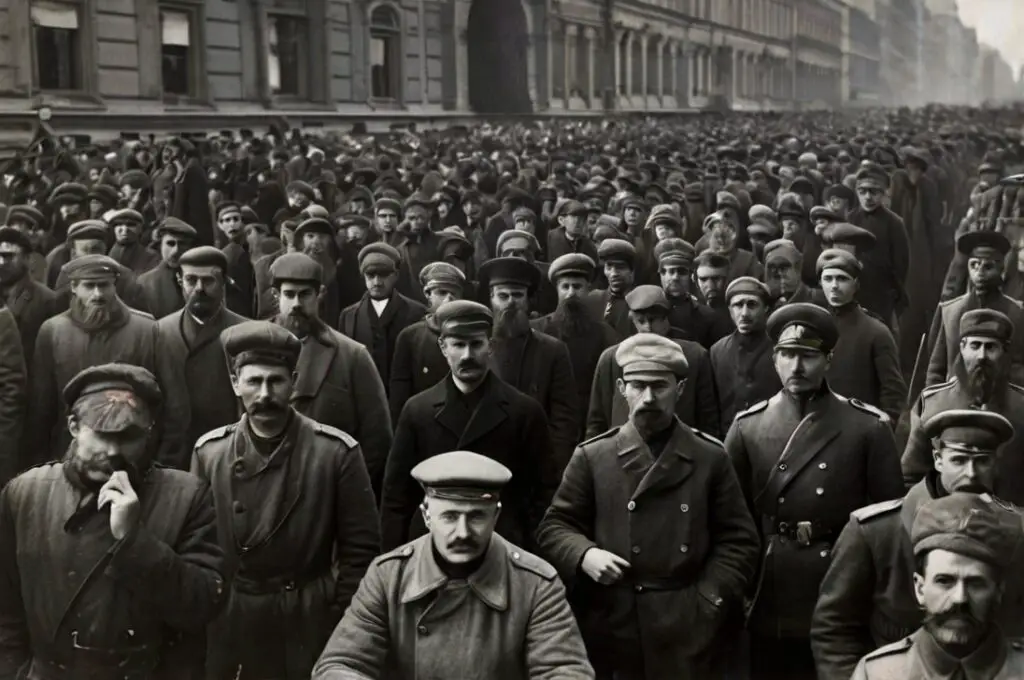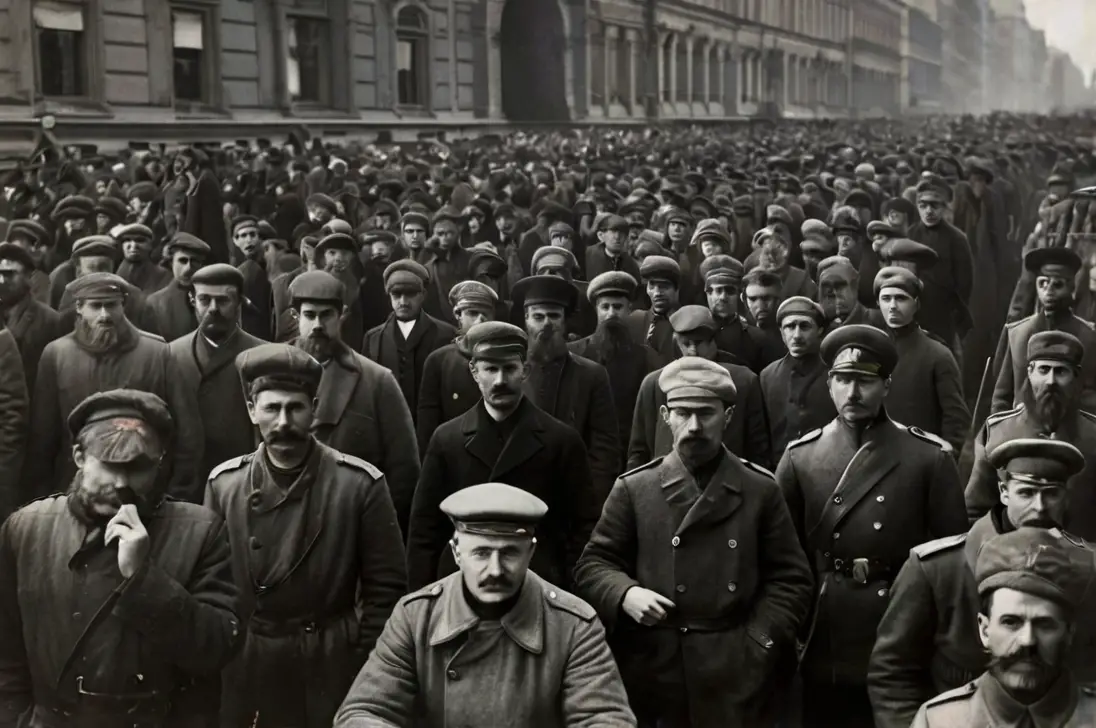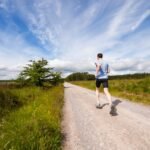
The Russian Revolution of 1917 was a monumental event that reshaped the course of world history.
It led to the overthrow of the Russian monarchy, the rise of the Soviet Union, and had far-reaching impacts on global politics.
This article delves into the causes, key figures, significant events, and the aftermath of the Russian Revolution, providing a thorough understanding of this pivotal period.
Causes of the Russian Revolution
The Russian Revolution was driven by several key factors, each contributing to the widespread unrest that led to the overthrow of the Tsarist regime.
Here’s a closer look at the main causes:
Social inequality
In early 20th-century Russia, there was a sharp divide between the rich and the poor.
Most Russians were peasants living in severe poverty, struggling to make ends meet.
In contrast, a small group of wealthy elites enjoyed luxurious lifestyles.
This deep social inequality created significant resentment and frustration among the majority of the population.
- Read also: The Execution of the Romanov Family – Myths And Facts Behind it
- Read also: Unveiling the Legends: 9 Iconic Russian Historical Figures
Political repression
Tsar Nicholas II ruled with absolute power, meaning he had complete control over the government and limited personal freedoms.
His autocratic rule stifled political dissent and repressed any opposition.
Many people, including political activists and ordinary citizens, grew increasingly frustrated with this lack of freedom and the oppressive political environment.
Economic hardships
The rapid industrialization of Russia came with serious drawbacks.
Factory workers faced terrible working conditions and meager wages.
At the same time, poor harvests led to food shortages and rising prices, which compounded the economic struggles of ordinary people.
This combination of industrial exploitation and economic instability made life very difficult for many Russians.
Military failures
Russia’s involvement in wars like the Russo-Japanese War and World War I highlighted significant issues within the military and government.
The country suffered heavy casualties and defeats, which not only demoralized the military but also fueled public discontent.
The perception of military incompetence and corruption further eroded trust in the leadership.

Key Figures of the Russian Revolution
The Russian Revolution involved several key figures who played crucial roles in shaping the course of events.
Here’s a detailed look at these important individuals:
Vladimir Lenin
Lenin was the leader of the Bolshevik Party and a central figure in the October Revolution of 1917.
His revolutionary ideas and strategic vision were pivotal in the success of the Bolshevik takeover.
Lenin advocated for a socialist state and led the Bolsheviks in their effort to overthrow the Provisional Government.
After the revolution, he became the first head of the Soviet state, establishing the foundations of what would become the Soviet Union.
Leon Trotsky
Trotsky was another prominent leader within the Bolshevik Party.
He played a key role in both the October Revolution and the Russian Civil War that followed.
As the People’s Commissar for Military and Naval Affairs, Trotsky was responsible for organizing and leading the Red Army, which was crucial in securing Bolshevik power during the civil conflict.
His military expertise and leadership were essential in the consolidation of Bolshevik control.
Tsar Nicholas II
Nicholas II was the last Emperor of Russia.
His reign was marked by significant political and social unrest, largely due to his ineffective leadership and reluctance to implement meaningful reforms.
His inability to address the growing discontent among the populace and his resistance to change contributed to the revolutionary atmosphere.
In March 1917, Nicholas II abdicated the throne, bringing an end to over 300 years of Romanov rule and paving the way for the revolutionary changes that followed.
Alexander Kerensky
Kerensky was a key figure in the Provisional Government that was established after the February Revolution of 1917.
As a member of this temporary government, he faced the challenge of maintaining control during a time of intense political turmoil and increasing Bolshevik influence.
Despite his efforts to stabilize the situation, Kerensky struggled to address the widespread dissatisfaction among the public and the growing power of the Bolsheviks, which ultimately led to the October Revolution and the fall of the Provisional Government.

Key Events of the Russian Revolution
Bloody Sunday (1905)
On January 22, 1905, a peaceful protest in St. Petersburg, led by a priest named Father Gapon, aimed to petition Tsar Nicholas II for better working conditions and political reforms.
However, when the crowd approached the Winter Palace, the Tsar’s troops opened fire, killing and wounding hundreds of demonstrators.
This tragic event, known as Bloody Sunday, sparked widespread outrage and unrest across Russia.
It significantly eroded public trust in the Tsar and set the stage for further revolutionary activity, ultimately contributing to the conditions leading up to the Russian Revolution of 1917.
The February Revolution (1917)
In February 1917, spontaneous protests and strikes broke out in Petrograd (now St. Petersburg) due to severe food shortages, poor working conditions, and general dissatisfaction with the Tsarist regime.
The unrest quickly escalated, and on March 2, 1917, Tsar Nicholas II abdicated the throne, ending over three centuries of Romanov rule.
In his place, a Provisional Government was established, but it struggled to manage the political and social chaos.
This government faced challenges in asserting its authority and addressing the demands of the people, setting the stage for further revolutionary developments later in the year.
The October Revolution (1917)
On October 25, 1917, the Bolshevik Party, led by Vladimir Lenin, orchestrated a well-planned coup against the Provisional Government.
This event, known as the October Revolution or Bolshevik Revolution, saw Bolshevik forces seize control of key government buildings and institutions in Petrograd.
The successful coup effectively dismantled the Provisional Government and marked the beginning of Bolshevik rule.
The revolution was a turning point, leading to the establishment of the Soviet state and significant changes in Russian society and politics.
The Russian Civil War (1917-1922)
Following the October Revolution, Russia plunged into a brutal civil war between the Red Army (Bolsheviks) and the White Army (anti-Bolshevik forces).
The conflict was intense and devastating, with both sides engaging in fierce battles and committing atrocities.
The Red Army, under the leadership of figures like Leon Trotsky, eventually emerged victorious.
Their win consolidated Bolshevik control over Russia and paved the way for the formation of the Soviet Union.
The civil war had far-reaching consequences, shaping the early years of Soviet rule and influencing the country’s political and social landscape.

Aftermath and Impact
The Russian Revolution had significant and far-reaching impacts on both Russia and the global stage.
Here’s a detailed look at its aftermath and effects:
Creation of the Soviet Union
The immediate outcome of the revolution was the establishment of the Soviet Union in 1922.
This was the world’s first socialist state, built on the principles of Marxism-Leninism.
The Soviet Union became a major global power, influencing international politics and economics throughout the 20th century.
It was a key player in the Cold War and had a profound impact on global affairs.
Global influence
The Russian Revolution inspired communist movements around the world.
Its success demonstrated that a socialist revolution could be achieved, encouraging similar movements in various countries.
This spread of communist and socialist ideas had a significant impact on global politics, leading to the rise of communist parties and revolutions in other nations.
Domestic changes
Under Bolshevik leadership, Russia underwent substantial changes:
- Land redistribution: Land was taken from the nobility and redistributed to peasants, aiming to address the deep social inequalities that had existed under the Tsarist regime.
- Industrial nationalization: Major industries were nationalized and brought under state control. This was part of a broader effort to centralize economic management.
- Planned economy: The government implemented a series of economic plans to control production and distribution, aiming to modernize the economy.
High costs
The dramatic changes came with significant costs:
Repression and totalitarianism
The Bolshevik regime, particularly under Joseph Stalin, became increasingly repressive.
Stalin’s rule led to the creation of a totalitarian state, characterized by strict government control, suppression of dissent, and extensive surveillance.
Collectivization and purges
The drive to collectivize agriculture forced many peasants into state-run collective farms.
This process was brutal and led to widespread suffering, including famine and displacement.
Additionally, Stalin’s purges targeted perceived political enemies, leading to the imprisonment and execution of millions of people.

- Read also: The Dawn of a New Era: How Did the Industrial Revolution Started
- Read also: Vive la Révolution! The Untold Stories of the French Revolution Facts
Conclusion
The Russian Revolution was a watershed moment in history that ended centuries of monarchical rule and led to the rise of the Soviet Union.
Driven by deep social, economic, and political discontent, the revolution brought profound changes to Russia and had a lasting global impact.
Understanding the causes, key figures, and events of the revolution provides valuable insights into the forces that shaped the 20th century.



